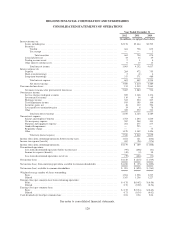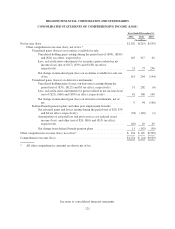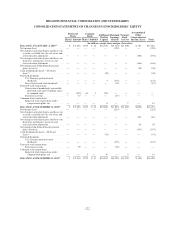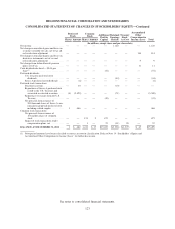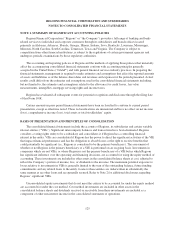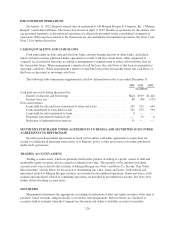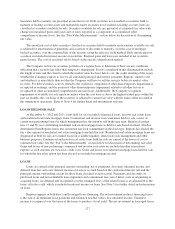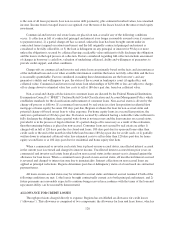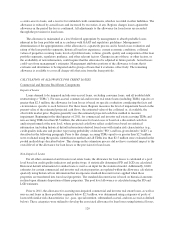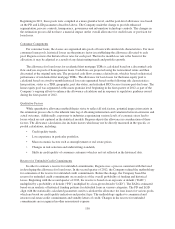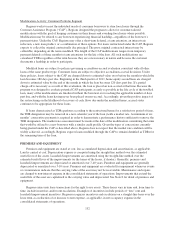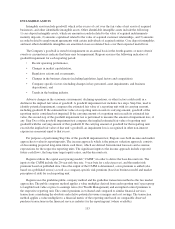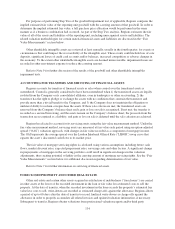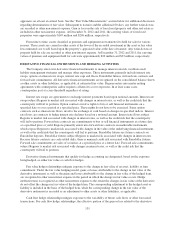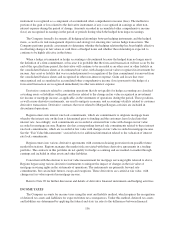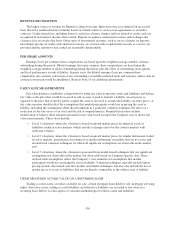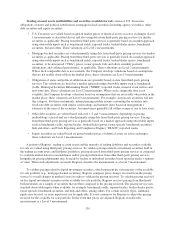Regions Bank 2012 Annual Report Download - page 145
Download and view the complete annual report
Please find page 145 of the 2012 Regions Bank annual report below. You can navigate through the pages in the report by either clicking on the pages listed below, or by using the keyword search tool below to find specific information within the annual report.
a contra-asset to loans, and a reserve for unfunded credit commitments, which is recorded in other liabilities. The
allowance is reduced by actual losses and increased by recoveries, if any. Regions charges losses against the
allowance in the period the loss is confirmed. All adjustments to the allowance for loan losses are recorded
through the provision for loan losses.
The allowance is maintained at a level believed appropriate by management to absorb probable losses
inherent in the loan portfolio and in accordance with GAAP and regulatory guidelines. Management’s
determination of the appropriateness of the allowance is a quarterly process and is based on an evaluation and
rating of the loan portfolio segments, historical loan loss experience, current economic conditions, collateral
values of properties securing loans, levels of problem loans, volume, growth, quality and composition of the loan
portfolio segments, regulatory guidance, and other relevant factors. Changes in any of these, or other factors, or
the availability of new information, could require that the allowance be adjusted in future periods. Actual losses
could vary from management’s estimates. Management attributes portions of the allowance to loans that it
evaluates and determines to be impaired and to groups of loans that it evaluates collectively. The remaining
allowance is available to cover all charge-offs that arise from the loan portfolio.
CALCULATION OF ALLOWANCE FOR CREDIT LOSSES
Commercial and Investor Real Estate Components
Impaired Loans
Loans deemed to be impaired include non-accrual loans, excluding consumer loans, and all troubled debt
restructurings (“TDRs”). For non-accrual commercial and investor real estate loans (including TDRs) equal to or
greater than $2.5 million, the allowance for loan losses is based on specific evaluation considering the facts and
circumstances specific to each borrower. For these loans, Regions measures the level of impairment based on the
present value of the estimated projected cash flows, the estimated value of the collateral or, if available, the
observable market price. Regions generally uses the estimated projected cash flow method to measure
impairment. Beginning in the third quarter of 2011, for commercial and investor real estate accruing TDRs and
non-accruing TDRs less than $2.5 million, the allowance for loan losses is based on a discounted cash flow
analysis performed at the note level, where projected cash flows reflect credit losses based on statistical
information (including historical default information) derived from loans with similar risk characteristics (e.g.,
credit quality indicator and product type) using probability of default (“PD”) and loss-given default (“LGD”) as
described in the following paragraph. Prior to this change, accruing TDRs equal to or greater than $2.5 million
were evaluated using the specific identification method and all TDRs less than $2.5 million were evaluated in the
pooled methodology described below. This change in the estimation process did not have a material impact to the
overall level of the allowance for loan losses or the provision for loan losses.
Non-Impaired Loans
For all other commercial and investor real estate loans, the allowance for loan losses is calculated at a pool
level based on credit quality indicators and product type. A statistically determined PD and LGD are calculated.
Historical default information for similar loans is used as an input for the statistical model. Additionally, LGD
estimates for certain commercial and investor real estate properties are updated within the allowance calculation
quarterly using historical loss information that incorporates standard discount factors applied when those
properties are transferred into foreclosed properties. The standard discount factor is based on historical amounts
realized upon ultimate disposition of these properties. The pool level allowance is calculated using the PD and
LGD estimates.
Prior to 2011, the allowance for accruing non-impaired commercial and investor real estate loans, as well as
non-accrual loans in those portfolio segments below $2.5 million, was determined using categories of pools of
loans with similar risk characteristics (i.e., pass, special mention, substandard accrual, and non-accrual as defined
below). These categories were utilized to develop the associated allowance for loan losses using historical losses.
129



